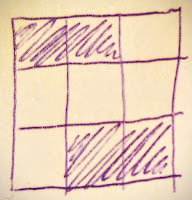Last week was very calm, as most algorithmic competition websites have called it a year or are busy preparing special New Year-themed competitions.
Nevertheless, AtCoder held its Grand Contest 008 right on Christmas Day (problems, results, top 5 on the left, analysis). In breaking with AGC tradition, the problems were quite technical and tedious this time. Big congratulations to apiad who has managed to get all of them accepted and won!
I have spent all 110 minutes on the attractive-looking problem F, severely underestimating the amount of things that can go wrong in its solution (I got it accepted after about 5 more minutes of debugging after the end of the contest). The problem simply asks: given a tree with some subset of its vertices colored black, consider all subsets of its vertices defined as "all vertices at distance at most d from some black vertex a" (for all combinations of d and a), and return the number of different such subsets. When the same subset is defined through several combinations of d and a, it must still be counted only once.
(Moscow Christmas on the left - compare to last year :)) In my previous summary, I have mentioned an interactive Open Cup problem: you needed to give a checkmate to a lone king on a 8x8 chessboard using just one piece - the amazon, that can move both as a queen and as a knight. To makes things harder, you are playing blindfolded and do not know the king's position or moves. More precisely, you are given the initial position of the amazon, and need to output such sequence of at most 50 moves that the king that starts in any position that is not checked by the amazon and makes any legal moves will eventually be checkmated at some point in this sequence, and will not be stalemated before that.
There are multiple approaches described in the post-match discussion, highlighting the fact that the problem allowed one's creativity to shine. However, the solution described by Endagorion also allows to answer the extra question I posted last week: how short can such sequence of moves be if the amazon starts at a1?
It turns out this shortest sequence is "a1 a2 b3 b4 c5 c6 c5 d4 d3 d4 e5 e6 e5 f4 f3 e5 f6" (16 moves). And to prove this, Endagorion simply runs a breadth-first search over all reachable states of the game. The state of the game, in this case, is the position of the amazon plus the set of positions where the opposite king can be. At first glance it seems like we might get 64*264 states, but in practice the number of reachable states is much, much lower - most likely because the set of reachable squares for the king fills any unattacked area reasonably quickly, and thus we get much fewer possibilities (just 312400 states are reachable, and only 54520 of those are traversed before we find a way to checkmate definitely).
Thanks for reading, and check back in 2017! Happy New Year!
Nevertheless, AtCoder held its Grand Contest 008 right on Christmas Day (problems, results, top 5 on the left, analysis). In breaking with AGC tradition, the problems were quite technical and tedious this time. Big congratulations to apiad who has managed to get all of them accepted and won!
I have spent all 110 minutes on the attractive-looking problem F, severely underestimating the amount of things that can go wrong in its solution (I got it accepted after about 5 more minutes of debugging after the end of the contest). The problem simply asks: given a tree with some subset of its vertices colored black, consider all subsets of its vertices defined as "all vertices at distance at most d from some black vertex a" (for all combinations of d and a), and return the number of different such subsets. When the same subset is defined through several combinations of d and a, it must still be counted only once.
(Moscow Christmas on the left - compare to last year :)) In my previous summary, I have mentioned an interactive Open Cup problem: you needed to give a checkmate to a lone king on a 8x8 chessboard using just one piece - the amazon, that can move both as a queen and as a knight. To makes things harder, you are playing blindfolded and do not know the king's position or moves. More precisely, you are given the initial position of the amazon, and need to output such sequence of at most 50 moves that the king that starts in any position that is not checked by the amazon and makes any legal moves will eventually be checkmated at some point in this sequence, and will not be stalemated before that.
There are multiple approaches described in the post-match discussion, highlighting the fact that the problem allowed one's creativity to shine. However, the solution described by Endagorion also allows to answer the extra question I posted last week: how short can such sequence of moves be if the amazon starts at a1?
It turns out this shortest sequence is "a1 a2 b3 b4 c5 c6 c5 d4 d3 d4 e5 e6 e5 f4 f3 e5 f6" (16 moves). And to prove this, Endagorion simply runs a breadth-first search over all reachable states of the game. The state of the game, in this case, is the position of the amazon plus the set of positions where the opposite king can be. At first glance it seems like we might get 64*264 states, but in practice the number of reachable states is much, much lower - most likely because the set of reachable squares for the king fills any unattacked area reasonably quickly, and thus we get much fewer possibilities (just 312400 states are reachable, and only 54520 of those are traversed before we find a way to checkmate definitely).
Thanks for reading, and check back in 2017! Happy New Year!















































